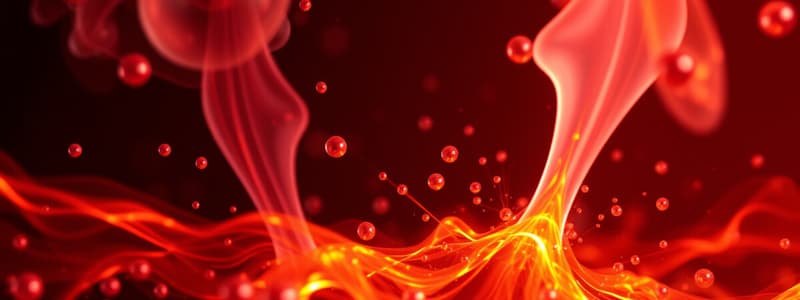Podcast
Questions and Answers
What primarily occurs to a pure substance when thermal energy is added?
What primarily occurs to a pure substance when thermal energy is added?
- The pressure remains constant.
- The particle motion decreases.
- The substance may change state. (correct)
- The temperature decreases.
When thermal energy is removed from a gas, what is the most likely change observed in particle motion?
When thermal energy is removed from a gas, what is the most likely change observed in particle motion?
- Particles move more slowly. (correct)
- Particles collide less frequently.
- Particles remain unaffected.
- Particles accelerate rapidly.
Which of the following could describe the process of a liquid becoming a solid as thermal energy is removed?
Which of the following could describe the process of a liquid becoming a solid as thermal energy is removed?
- Evaporation
- Sublimation
- Freezing (correct)
- Melting
How does the addition of thermal energy generally affect the state of a solid substance?
How does the addition of thermal energy generally affect the state of a solid substance?
What happens to the temperature of a substance at its melting point when additional thermal energy is added?
What happens to the temperature of a substance at its melting point when additional thermal energy is added?
Describe how the motion of particles in a solid changes when thermal energy is added.
Describe how the motion of particles in a solid changes when thermal energy is added.
What effect does the removal of thermal energy have on the temperature of a gas?
What effect does the removal of thermal energy have on the temperature of a gas?
How does the state of a pure substance change when thermal energy is added at its boiling point?
How does the state of a pure substance change when thermal energy is added at its boiling point?
Explain what happens to the particles of a liquid when it freezes due to the removal of thermal energy.
Explain what happens to the particles of a liquid when it freezes due to the removal of thermal energy.
What is the relationship between thermal energy and temperature for a pure substance during a phase change?
What is the relationship between thermal energy and temperature for a pure substance during a phase change?
Study Notes
Particle Motion and Thermal Energy
- Adding thermal energy increases the kinetic energy of particles, causing them to move faster.
- Reduced thermal energy decreases particle motion, leading to slower movement and closer proximity between particles.
Temperature Changes
- Temperature is a measure of the average kinetic energy of particles in a substance.
- Increasing temperature indicates that particles are moving more rapidly, while decreasing temperature shows a reduction in particle movement.
States of Matter
- Solid: Particles are closely packed in a fixed position; minimal movement; low thermal energy.
- Liquid: Particles are close but can slide past each other; moderate thermal energy; takes the shape of the container.
- Gas: Particles are far apart and move freely; high thermal energy; expand to fill the container.
Phase Changes
- Melting: Addition of thermal energy transforms a solid into a liquid as particles gain enough energy to move freely.
- Freezing: Removal of thermal energy causes a liquid to become solid as particle motion decreases.
- Vaporization: Increasing thermal energy allows a liquid to transform into a gas, with particles breaking free from the liquid state.
- Condensation: Removing thermal energy results in gas becoming a liquid as particles slow down and come closer together.
- Sublimation: Direct transition from solid to gas occurs with significant thermal energy addition, bypassing the liquid state.
- Deposition: Gas changes directly to a solid through thermal energy removal, transitioning without becoming liquid.
Energy Transfer and Equilibrium
- Heat energy moves from areas of higher temperature to lower temperature until thermal equilibrium is reached.
- Changes in state require specific amounts of thermal energy known as latent heat, depending on the substance and phase change involved.
Changes in Particle Motion
- Addition of thermal energy increases particle motion, causing particles to move faster.
- Removal of thermal energy slows down particle motion, resulting in reduced kinetic energy.
- In solids, particles vibrate in fixed positions; in liquids, they move more freely; in gases, they move independently and rapidly.
Temperature Changes
- Temperature is a measure of the average kinetic energy of particles.
- Increasing thermal energy raises the temperature, resulting in faster-moving particles.
- Decreasing thermal energy lowers the temperature, resulting in slower-moving particles.
- Temperature changes can indicate phase transitions, such as melting or boiling.
State Changes of a Pure Substance
- Melting occurs when a solid absorbs thermal energy, transitioning to a liquid state.
- Boiling occurs when a liquid absorbs enough thermal energy to become a gas.
- Freezing occurs when a liquid loses thermal energy and transitions to a solid state.
- Condensation occurs when a gas loses thermal energy to become a liquid.
- Sublimation involves a solid transitioning directly to a gas when thermal energy is added without passing through the liquid state.
Phase Diagrams
- Phase diagrams illustrate the states of a substance at varying temperatures and pressure.
- Critical points on these diagrams indicate conditions where distinct phases coexist.
- The diagram helps predict the state of a substance at specific temperature and pressure conditions.
Energy Transfer Mechanisms
- Conduction, convection, and radiation are methods of thermal energy transfer affecting particle behavior.
- Conductive transfer occurs through direct contact, allowing energy to move to cooler substances.
- Convection involves the movement of fluids, as warmer fluid rises and cooler fluid sinks.
- Radiative transfer allows thermal energy to move through space via electromagnetic waves.
Studying That Suits You
Use AI to generate personalized quizzes and flashcards to suit your learning preferences.
Description
This quiz explores the concepts of particle motion, temperature changes, and state changes of a pure substance when subjected to thermal energy transfer. Test your understanding of how these factors influence each other in thermodynamic processes.




